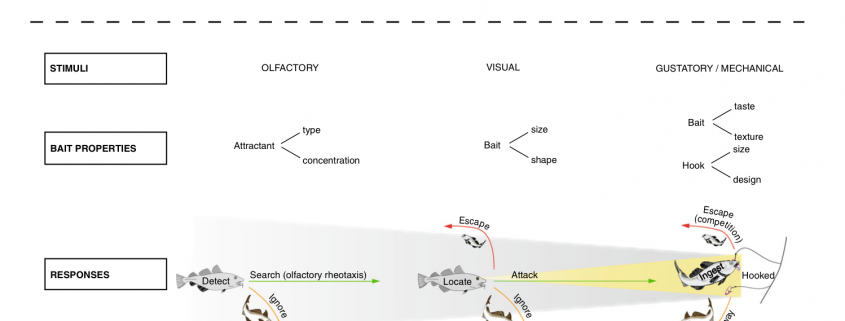Towards more efficient longline fisheries: fish feeding behavior, bait characteristics and development.
By Sarah Hirth, RJD Intern
There has been a growing demand for bait resources seeing that standard bait types, such as squid, herring and mackerel are also used for human consumption. As a result, bait prices have increased, thus increasing the demand for an alternative bait, one that is not based on resources used for human consumption. This study highlights factors that need to be taken into consideration when looking for alternative bait, and explores attempts of alternative baits that have been made.
Løkkeborg at al. agree that an alternative bait should be “effective, species- and size-selective, practical for storage and baiting, and based on low-cost surplus products.” An alternative bait that would meet all of these characteristics would also make the procedure of longline fishing more environmentally friendly.
Although there have been several attempts to develop alternative baits, these have had limited success (e.g. Bjordal and Løkkeborg 1996; Januma et al. 2003; Polet al. 2008; Henriksen 2009). There have been two main methods, which have been used to create the alternative bait. These are natural resources, such as surplus products from the fishing industry and synthetic ingredients as attractants. Mentioned types of alternative bait are: Norbait, artificial bait invented by William E.S. Carr, bait bags, and arom bait.
When these baits were tested, they all resulted in some positive factors. However, they still had undesirable outcomes. For example Norbait, which is based on surplus products, where minced fish products are mixed with alginate (a gelling agent, used as the binder) and extruded into a fiber mesh tube, has resulted in species –selective effects. In fishing trials Norbait has resulted in increased catch rates of two to three hundred per cent for haddock, yet Norbait compared poorly to natural bait for cod. “Compared to natural bait, minced herring enclosed in a nylon bag resulted in a 58% higher catch rates for haddock, a non-significant catch increase for tusk and ling, and a considerably lower catch rate for cod.” Similar results were observed with the other types of alternative baits.
The efficiency of longline baits depends on several factors, which are important to take into consideration when finding alternative baits. Some factors include: bait size, texture, and taste. An alternative bait also needs to be based on an odor source, and attractants need to be released over a considerable period of time. Løkkeborg et al. state that “the knowledge of food search behavior in fish is the basis of bait development efforts.” The list of factors affecting feeding behavior in this review includes: temperature, feeding motivation and hunger state, diel, tidal and annual rhythms, light levels, seasonal change in photoperiod, and water currents.
Although there currently are no alternative baits used in longline fishing, Løkkeborg et al. hope that improved knowledge of how fish respond to baited gear will aid future research aimed at the development of alternative baits. As the demand for marine resources for human consumption continues to increase, costs for longline bait are also likely to keep increasing. “The development of alternative baits used on resources not used for human consumption may therefore prove to be critical to a viable longline fisheries.”
Løkkeborg, S., et al. (2014). “Towards more efficient longline fisheries: fish feeding behaviour, bait characteristics and development of alternative baits.” Reviews in Fish Biology and Fisheries 24(4): 985-1003.






Leave a Reply
Want to join the discussion?Feel free to contribute!